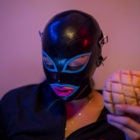With more and more movie streaming services popping up, it can feel impossible to keep track of what’s showing where. So to help, this October I’ll be recommending a different film every day from one such service that embodies the spooky spirit of the season. From classic Halloween movies to indie horror to campy dark comedies, this is 31 Days of a Very Chingy Halloween.
Today I’m looking at Wes Craven’s final film, Scream 4, currently available to stream on Starz.
Though Freddy Krueger of the Nightmare on Elm Street series is horror luminary Wes Craven’s most famous creation, his greatest success, both critically and commercially, is the Scream series. In fact, the original 1996 film was the highest-grossing slasher flick of all time until 2018’s Halloween.
Rather than focusing on the exploits of one killer, Scream’s killer — the shrouded Ghostface — was an identity different people would take on over the course of the films, with the common goal of terrorizing and murdering heroine Sidney Prescott (Neve Campbell) and everyone close to her. Scream was famous for being the postmodern slasher franchise, a self-aware horror movie in which everyone watched horror movies and knew the rules of the genre.
Scream and Scream 2 blended silly humor with gripping suspense and walked a tightrope where their kills were a balanced mix of the satirical and the shocking. That delicate balance tipped with 2000’s Scream 3, an underwhelming film that was far more concerned with humor than horror (and was at least partially influenced by the 1999 Columbine Massacre). But 11 years later (and 15 years after the original film), the franchise would be redeemed with an innovative entry that was equal parts sequel and reboot.
So what exactly was it that Scream 4 had that its immediate predecessor was so clearly lacking? On paper, it was the presence of screenwriter Kevin Williamson (I Know What You Did Last Summer and Dawson’s Creek), who penned all but the third entry in the series. Stylistically, too, Scream 4 was an overall return to form, revisiting the small town setting of the first two films (the third had taken place on the Hollywood set of the movie adaptation of the first film’s events).
While Sidney was once again at the center of the killings, she’s no longer the anxious teen heroine, with her younger cousin Jill (Emma Roberts) and her friends filling the roles many of Sidney’s own friends used to fill (the horror junkie, the plucky blonde, the jock, etc.) and serving as a whole new slew of possible Ghostfaces. It expertly captures the tone of the first film with its quiet suburbia and the ill-equipped incompetence of local law enforcement, while also exploring how the genre had developed in the new millennium, the impact of social media and the ways in which teens had changed (as well as how they’d stayed the same).
So many horror reboots of the time completely misunderstood the success of their franchises, attempting to revitalize them without ever realizing what made them vital in the first place. A prime example is the 2010 remake of A Nightmare on Elm Street (of which Craven wasn’t involved), which, with the trend of the times, went for a darker and more sinister take on dream murderer Freddy Krueger, changing him into a sadistic pedophile without realizing that people love Freddy for the campiness that comes with his cruelty. But Scream 4, helmed by the men who started the series, perfectly recognized what its audiences liked so much about the original and how they could update it for modern times.
So in the time honored tradition of Ghostface, I ask, “What’s your favorite scary movie?” Scream 4 is definitely one of mine.

